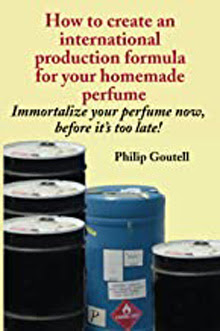 |
| Dipping the candle into a container of hot beeswax |
I was reading about some small, prestige (luxury) perfume marketer and noted that among their offerings were candles. Successful, smallish luxury perfumeries always seem to offer candles. Candles are easy to make and you don't have the shipping restrictions that come with (liquid) perfume.
As kids in grade school we made candles for Christmas, one red, one green -- or two brown if you mixed up the red wax with the green wax and dipped into the wrong pot.
Anyway, between reading about luxury perfumeries and their candles, childhood memories of making candles, and a box of beeswax I had for making solid perfumes, making a few candles seemed like a fun idea. All I lacked (so I thought) was wicks.
Wicks are easy to find online. They don't cost much and mine arrived quickly. I ordered wicking for "hand dipped tapers." Different styles of candles require different types of wicks or so I read. I haven't made any tests.
My wicks arrived, I set aside some time, I gathered up my materials and started on the project. The first issue was containers. I had the hotplate I'd been using to melt wax for solid perfumes. I had a pot to melt the wax in. The problem was to find a container into which I would pour the liquid wax after running it through a strainer to get out the larger impurities. This was, after all, unprocessed wax, wax straight from the beehive.
I had envisioned making dipped candles at least eight to ten inches tall. The best container I could find in my studio was only about four inches tall.
Now here's the scoop on dipping containers. Ideally they should be an inch or two taller than the size of the candle you want to make. To get the candle started, you need to tie a weight on the end of the wick to keep the wick straight until you've dipped it enough so the wax itself will keep it straight.
The other issue of the dipping container is that you have to fill it with liquid wax. The greater the diameter of your pot, the more wax you'll need to melt and filter to fill the container. The diameter of my container was small, meaning I wouldn't need too much wax to fill it, only slightly more than what would go into the candle itself.
Now, with my equipment prepared, I began to execute the steps.
Wax burns so you've got to be careful when melting it. Also, since both pot and wax are hot, you must be careful so as not to burn yourself. I put the container with the wax in a Pyrex measuring cup and filled the cup part way with water, just enough water so that the wax container wouldn't float.
Then I set the hotplate burner on high and took out a book. It takes a while for the wax to melt and you don't want to leave this operation unattended. Too many hazards. The wrong people could wander by, spilled wax could catch fire. Just stay there and keep an eye on it from start to finish.
Bees wax has a pleasant scent of its own but because this is just an experiment for me, a test, I added some fragrance to the wax, a couple of small blocks of a solid perfume, wax that has already been scented.
When the original, right from the beehive, wax has melted, I poured it through a strainer into another container. This is now the clean wax.
Now I fill the dipping container with the clean wax and begin dipping, lowering the wick until the bolt hits the bottom of the can. I want to keep the wick as straight as possible as I dip so my candle will be straight.
To speed the operation I have a tank of cool water and each time I dip my candle in hot wax I then dip it in the cool water so the wax will harden and I'll be ready to dip again.
Here I've dipped until my candle is almost as wide as the opening in the dipping container. Then I'm finished.
I let the finished candle set for a while in the cool water. Then I trim the wick and I'm done.
The result? Small but beautiful and burning with wonderful scent.
I've posted some more photos of this project along with a few more comments on my website. You might enjoy looking at them.




